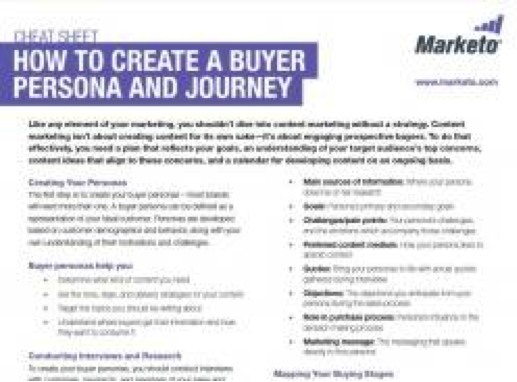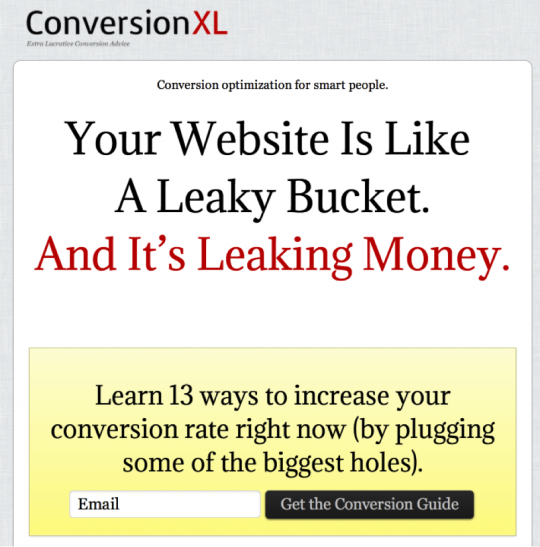The 1-2 Landing Page Punch that Will Boost Conversions

[Guest post by Jeremy Smith]
Many marketers get so caught up in the technique of marketing that they neglect the human element behind it. Ecommerce, despite its digital facade, is an intensely human platform because it’s driven by people buying stuff from other people.
This realization — commerce’s status as a platform of exchange between two human beings — leads me to another observation. If we don’t communicate to people in our marketing, then people won’t respond. If we don’t interact with people, then our efforts are completely useless.
In other words, you need to make your marketing efforts more people-focused and less conversion-focused.
I’m going to explain exactly how you can do this on your landing pages.
In overview form, it’s a one-two punch. I describe it that way, not because I love boxing or violence, but because this is a simple technique involving two steps — the prep punch, and then the KO.
1. Understand who they are. Ask questions.
The first stage of humanizing your landing pages is to get into the head of your audience. Understand everything you can about them.
This is the idea: Who are they?
An article in The Ladders put this concept simply and powerfully: “Before you say it or write it, think about the listener and reader. How do they want to hear it and read it?”
Shawn O’Conner distilled this point in his series on Successful Startups in Forbes. He stressed the need to “know your audience” in the following way:
The first step in this endeavor is to get to know your audience. You need to ask yourself to whom should you market and how do you most efficiently reach them? This will include identifying the age, gender, geographic location, socioeconomic status and other demographic and psychographic traits of the consumers who would be most interested in purchasing your product or service. This is crucial information that must factor into your decision of where and how to spend your precious dollars marketing your new business.
The idea is simple: Know your audience.
Human communication, even on a landing page, is not successful unless you know your intended audience and speak directly to them. The audience, whoever they are, will respond to your message in some way. Will it be the right way? Will it score conversions?
It will only if you understand your audience.
This is how you do it: Ask questions.
In order to understand who your audience is, you need to raise all the important questions.
Back up and look at your the big picture.
Here’s the problem. We’re so often focused on one small portion of marketing — conversions. This is a dangerous starting point, though. When we focus on this small area of marketing, we neglect the broader vistas of marketing. These are precisely the things that give us powerful perspective in our marketing efforts.
Take a look at this diagram of the marketing process.
Most of us are myopically focused on technique, which distills the entire process into a series of landing pages, images, and CTAs. We’re mucking around in the last phase of the process — that point at which we put our entire product, value prop, strategy, and plan in front of the customer. But how do we get to that final point of completion?
We make sure that we’ve asked the right questions leading up to it.
Most of us need to back up and examine the whole process
? Offering – what are we selling?
? Value proposition – what good is it?
? Marketing Strategy – what’s the best way to get it in front of our target audience?
? Marketing plan – What channels and techniques will we use to implement our strategy?
? Target audience – What does the audience now do?
Here’s a quick exercise that will help you do that. It’s a good ol’ fashioned fill-in-the-blank.
? I am offering _________.
? The reason why it is so awesome is because ____________.
? The people that need to hear about this are ____________.
? The strategy that I will use to present it to them is _____________.
? The techniques I will use as I present it to them will include ___________.
That’s the big picture, but there’s a smaller picture in here that we need to take a closer look at.
Figuring out your audience.
The most direct way to figure out your audience is to go through the formal process of creating a buyer persona. Here are a few helpful resources for doing so:
Hubspot has a great resource on Buyer Personas, that comes with a free template.
Marketo has a guide on creating a buyer persona that adds the angle of their journey. This is an often-overlooked but equally important aspect of your audience’s identity — their journey.
An article on Marketing Before Funding helps to distill the entire process of buyer persona into 8 cogent components.
The folks at Groove Digital Marketing have provided a few helpful points on personas that is worth checking out.
Adele Rivella discusses in her Content Marketing Institute piece a few mistakes on creating buyer personas. I think it’s an important quick read as you make sure you’re sketching things the right way.
What conventional marketing personas miss.
I strongly believe that you should develop a marketing persona, but it’s easy to miss a few things. One of those easy-to-miss features is pain.
Pain is the neuroscientific spark that fuels so much of our purchasing decisions. Christophe Morin heads up a marketing agency called SalesBrain, which is reportedly the world’s first neuromarketing agency. Morin is the organization’s Chief Pain Officer. His belief in the power of pain shapes his entire approach to marketing. As a New York Times piece on Morin and his agency discussed,
“Pain” is in his title because his company’s approach is to help marketers look at the frustrations and challenges consumers experience. “Humans are pain-avoiding machines,” Mr. Morin said. “Sometimes our pain points are conscious and sometimes unconscious.”
As you seek to understand your audience, get at their pain. What pain are they trying to avoid? What pain are they feeling that they want to get rid of? What pain do they anticipate that they want to escape?
Pain, pain, pain. If you know their pain, you will own the key to the your audience’s passions. You will turn them into customers.
ConversionXL understands a bit about this concept of pain. Their audience, consisting of digital marketers doesn’t want to lose money from their websites. This in-your-face headline is exactly what will help them convert to “get the conversion guide.”
The blog, Quicksprout.com, also targets pain points. The audience of SEOs and site owners crave traffic. Lack of traffic is a serious pain point. That’s why this CTA is so effective:
Once you understand the audience’s pain, speak to that pain. Dig at it, make them feel it, and then provide a cure.
Neuroscience helps you connect.
A powerful piece in Inc.com distilled the way that neuroscience can shape our understanding of delivering information to our audience in the most powerful way. Here it is:
Over the past few decades, enormous amounts of effort (and dollars) have gone into understanding how the mind works. This is good news for you, especially when it comes to public speaking, which requires getting into the minds (and hearts) of an audience. Neuroscience research offers loads of insights that every business person ought to apply to presentations.
I read the Inc. article due to its emphasis upon neuroscience, but I realized that the findings apply just as well to public speaking as they do to conversion optimization. Here is how the findings from neuroscience helps us connect to our audience:
? Use terms that the audience understands. This affects your actual vocabulary. Don’t use the term CRO unless you’re talking to a group of conversion junkies.
? Use proof that resonates with the audience’s experience. How are you going to prove your point? What arguments will you use? Hopefully, you’ll choose to cite experiences that your audience has had or can relate to.
? Provide details that your audience can understand. Details are the cement that join the bricks of your content together. Details in visual and verbal form are critical.
2. Write to them. Give answers.
If you’ve done the hard work of getting all the information you can about your audience, then this second punch is going to be incredibly successful.
This is the idea: Tell them what they want to hear
Now that you’ve asked all the questions, you hopefully understand your audience. Now what?
You tell them what they want to hear.
This isn’t hucksterism. This is genuine sales. Why? You tell them what they want to hear, because you have a product that they want.
Let’s go back that survey of the “big picture” we discussed above. Remember that whole offering bit? That’s where we’re supposed to start. If we’re selling the right thing to the right person, then we know that they want it.
Now we just have to tell them about it. If they want it, then they want to hear about it.
And what do they want to hear? Precisely this…
? Something relevant.
? Something that will prevent pain.
? Something that will relieve pain.
Tell them something relevant.
Relevancy is the touchstone of interest. If a message lacks relevance, your audience will totally ignore it.

Image from New Media and Marketing.
This is why you went to all the work of developing a buyer persona. You wanted to find out what was relevant to your audience.
Knowing all you can about your audience allows to you give them the information that they are interested in. It’s a matter of connecting the dots.
Consider how a single demographic datapoint will shape your message of relevancy:
? Urban Male: 27 years old
So this guy lives in the city. He’s a millennial. Thus, he has a mobile phone, and wants to be trendy. Several strategies emerge:
? You should use contemporary language in your marketing efforts.
? You should connect with him on his mobile device. Mobile landing pages, SMS, or email marketing will be the strategic approach.
Relevancy is the entry point to a successful marketing endeavor.
Tell them about something that will prevent pain or relieve pain.
Now, we get into the issue of pain — the most powerful marketing method.
Humans are wired to want to avoid pain. In a well-known study, subjects felt the pain of losing money more acutely than they felt the joy of gaining an equal sum of money.
Here’s how they average consumer responds to either losing money and gaining the same amount:
? Losing $50: HECK NO! GIVE IT BACK! AGH!
? Gaining $50. Meh. Sure. Yeah. That’s nice.
As Roger Dooley put it: “Fear of loss trumps desire to gain.”
Loss is pain. If you can help your users avoid the pain of loss, you will score big. How does your product help to save them money, prevent them from losing money, or keep what is theirs? This is the pain point that will turn a skeptical audience member into an eager money-out-and-ready-to-buy customer.
Most humans anticipate future pain. In fact, as New Scientist described, “Waiting for pain can cause more dread than pain itself.” The Harvard Business Review published an article on the study that backs up this claim. The study pushed this conclusion — anticipating pain is actually worse than feeling it! It’s got neuroscientific roots.
If you can make your audience anticipate a future pain, then you wield enormous psychological control. By causing them to reflect upon the power and significance of this pain, you will cause them to react in a way that causes them to convert.
Pain sounds very unpleasant. And it is. But your goal is not to make your audience wallow in pain. Your goal is to relieve that pain. Messaging that focuses on the relief of the pain over against the experience of the pain will be the type of messaging that wins in the end.
Conclusion
The way to formulate a landing page for maximum conversion power is with this simple model: 1) Before you do anything, know your audience. Ask a lot of questions to get inside their head. Most importantly, figure out their pain points. Then, when you go to selecting images and writing your landing page copy, 2) Speak directly to your audience. Subtly reference their desire to alleviate their present pain or avoid future pain.
Do this, then spread your arms wide and wait for the conversions to start raining down.
Or something like that. Seriously, it’s going to be good.






